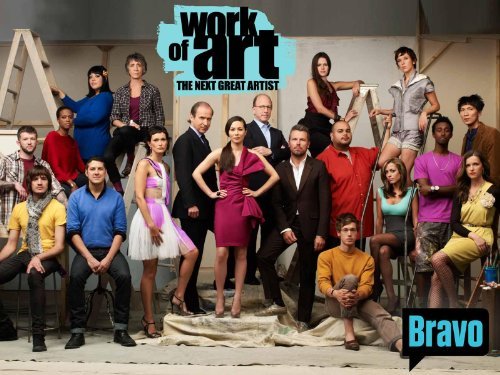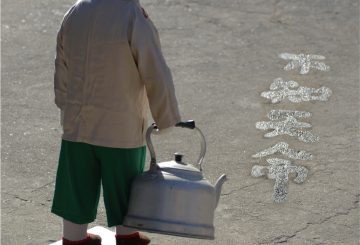No one really believed that reality television had anything to do with reality, at least until Andrew Frost watched ‘Work of Art’…
The rules were fairly simple. The artists arrived at a warehouse full of junk electronics – old TVs, gaming consoles, clocks, lamps, telephones and more – and were told they had to make a sculpture out of whatever they could lay their hands on. Of course with these kinds of shows there was a time limit so, with giant orange plastic trolleys in tow, the artists had 30 minutes to scramble through the wreckage, pull out whatever they could find and then cart it all back to the studio. What to make? And how to make it? And, oh my god, the clock is ticking!
This was the opening of episode two of Work of Art: The Next Great Artist, a new art-themed reality TV show that recently made its debut on STUDIO, the Foxtel cable arts channel. This “new” series is actually two years old, the show already having completed its second season in the US on the cable network Bravo last year, but it’s still extraordinarily entertaining.
The show is the brainchild of executive producer Sarah Jessica Parker and is a knock off of her other baby, the fashion-themed reality TV show Project Runway. The two programs share almost identical formats. In Work of Art 14 contestants are selected, given studio space and each week they are set tasks – make a self portrait, do a portrait of someone, make a junk sculpture, and so on. The group is shepherded through the process by a kindly father figure, judged by a panel of experts, and then one is selected as winner, and one loses and is asked to leave.
There have been some attempts in the past at creating an art-world reality show. In 2006 New York gallerist Jeffrey Deitch (now director of the Museum of Contemporary Art in Los Angeles) was a part of the ill-fated Artstar, a show that served as a vehicle to promote his gallery and artists. It began with a familiar reality TV show format with the artists competing for the plum prize of a solo show at Deitch Projects but anarchy broke out when the artists rebelled against their boring assigned tasks and the competition part of the show was dropped. In the end, instead of a solo show, a group show was staged and no actual “winner” was declared. With its low production values and generally poor art, Artstar was like watching the board of an artist-run gallery bicker and bitch among themselves. In 2009 the BBC’s School of Saatchi brought in a crop of UK hopefuls and, with art critic Matthew Collings and artist Tracey Emin appearing, the production values were much higher. Its reception was less than warm – British art critic Jonathan Jones declared that reality TV had nothing to offer humanity. With the strange non-appearance of Saatchi himself on the show (for medical reasons apparently), School of Saatchi was another not-to-be-repeated one-off.
But back to Work of Art. In the sculpture challenge, many of the contestants struggled with a new and unfamiliar medium – some of the painters had no idea how to make a sculpture while others with almost no craft skills at all just drizzled their “found objects” with paint and hoped no one would notice. Meanwhile, boy wonder and self-diagnosed OCD sufferer Miles decided he’d make a bed instead because he was so tired from all the hard work. He silk screened a circuit board diagram on to a piece of cloth and sewed a giant pillow cover. He then made a giant pillow, and two giant anuses out of concrete, and hung a painting with a single red dot in the middle next to his makeshift bed ensemble. What it had to do with the challenge no one could really tell, but everyone liked it.
The real focus of reality shows are the personalities of the contestants. It’s all about conflicts and successes and, perhaps best of all, the cruel failures. But the added bonus of an art-themed show is how much the contestants play out the stereotypes of the art world. You know these people – the pushy middle-aged woman artist who just isn’t going to take any shit (or advice) from anyone; the up-and-coming boy genius lacking social skills; the beer-drinking, tattooed-bloke artist with a ready smile but no ideas; the socially adept gay kid with a sarcastic wit and penchant for baroque over-the-top decoration; the talented female painter who looks like a model (and whom no one takes seriously). And so on. Work of Art sticks so closely to the stereotypes that when I watch it I am simultaneously repelled by its idiocy but thrilled by an intense feelings of recognition.
Aside from being types themselves, the contestants also make very familiar art too, and that helps the judges make banal statements of the obvious when deciding who is the winner. The host of Work of Art is Tina Chow, whose only claim to fame is that her father owned a restaurant that Andy Warhol ate at. Judges Jeanne Greenberg Rohatyn, “a gallerist, art advisor, independent curator, collector, and tastemaker” and Bill Powers, the co-owner of a NYC gallery and a “curator” of stock in a posh bookshop, offer nothing but tired platitudes, while “two-time Pulitzer Prize finalist in Criticism” Jerry Saltz of New York Magazine isn’t afraid to say the things that others fear to say, or indeed, probably don’t understand. When Miles won the episode for his sleep ensemble, and had pretended to go to sleep on it for good measure during the judging at the “opening” at the show’s fake gallery space, Saltz opined that it was so great how Miles “had activated the space” by dozing off.
The sobering aspect of Work of Art is that its success is all about its dogged adherence to the reality TV show format. There are no super-famous collector-gallerists to hijack the show, none of this “let’s throw out the rules!” nonsense – this is a competition to find a winner. No matter how unpleasant it might seem, Work of Art so perfectly captures the art world and everyone and thing in it that it is truly scary. And unmissable.


